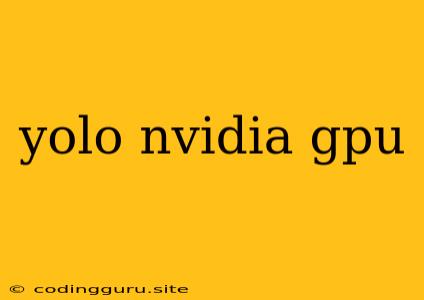YOLO: A Revolution in Real-Time Object Detection, Powered by NVIDIA GPUs
You've likely heard of the incredible advances in object detection powered by deep learning. This technology has transformed a wide range of industries, from self-driving cars to medical imaging. But among these advancements, one stands out for its speed and efficiency: YOLO, or You Only Look Once.
What is YOLO?
YOLO is a revolutionary real-time object detection algorithm that has made a significant impact on the field. Unlike traditional object detection methods that scan images piece by piece, YOLO processes the entire image in a single pass, making it incredibly fast. This speed is crucial for applications requiring instant feedback, such as autonomous vehicles, surveillance systems, and robotics.
Why NVIDIA GPUs for YOLO?
YOLO is computationally intensive, demanding immense processing power. This is where NVIDIA GPUs come in, offering the horsepower needed to execute YOLO models at lightning speeds. Here's why NVIDIA GPUs are the ideal choice for YOLO:
- Parallel Processing Power: NVIDIA GPUs are specifically designed for parallel processing, enabling them to handle the massive number of calculations required by YOLO models.
- Tensor Cores: NVIDIA's Tensor Cores are specialized units optimized for matrix multiplication, a key operation in deep learning. This makes NVIDIA GPUs exceptionally efficient for YOLO workloads.
- CUDA and cuDNN: NVIDIA's CUDA platform and cuDNN library provide optimized libraries and frameworks for deep learning tasks, further accelerating YOLO performance.
How to Get Started with YOLO and NVIDIA GPUs:
- Choose a Framework: Popular deep learning frameworks like TensorFlow and PyTorch offer pre-trained YOLO models and tools for fine-tuning and deployment.
- Select an NVIDIA GPU: NVIDIA offers a range of GPUs, from entry-level models like the GeForce GTX 1660 Super to high-end options like the GeForce RTX 3090, catering to different performance needs and budgets.
- Install and Configure: Install the necessary drivers, libraries, and frameworks to run YOLO on your NVIDIA GPU.
- Train Your Model: Use a dataset of images to train a custom YOLO model to detect specific objects.
- Optimize for Performance: Experiment with different parameters and settings to optimize the speed and accuracy of your YOLO model.
Examples of YOLO Applications:
- Self-Driving Cars: Detecting pedestrians, traffic signs, and other objects in real time to enable autonomous navigation.
- Surveillance Systems: Identifying suspicious activity and triggering alerts based on detected objects.
- Robotics: Enabling robots to interact with their environment by understanding and responding to objects.
- Medical Imaging: Analyzing medical images to detect anomalies and assist in diagnosis.
- Retail Analytics: Tracking customer movements, product selection, and inventory management for improved retail efficiency.
Benefits of Using YOLO with NVIDIA GPUs:
- Real-Time Performance: Achieve extremely fast object detection, enabling applications to respond instantly.
- High Accuracy: YOLO models are highly accurate, capable of reliably identifying objects in various scenarios.
- Scalability: The combination of YOLO and NVIDIA GPUs can be scaled for use in complex applications with demanding performance requirements.
- Flexibility: YOLO can be adapted to detect a wide range of objects, making it versatile for different tasks.
- Cost-Effectiveness: While NVIDIA GPUs represent an investment, their performance and efficiency can significantly improve the cost-effectiveness of your object detection applications.
Conclusion:
YOLO is a groundbreaking algorithm that has revolutionized real-time object detection, and NVIDIA GPUs are the perfect partner to unlock its full potential. The speed, accuracy, and scalability offered by this combination have made it a crucial technology for various industries. As deep learning continues to advance, YOLO and NVIDIA GPUs will continue to play a vital role in shaping the future of object detection and its applications.
